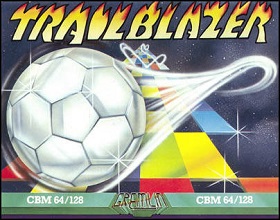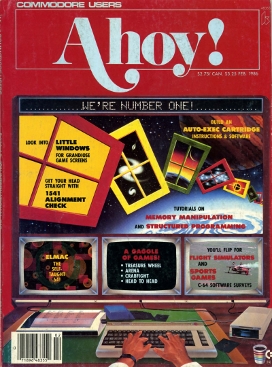
Amiga is a family of personal computers introduced by Commodore in 1985. The original model is one of a number of mid-1980s computers with 16- or 16/32-bit processors, 256 KB or more of RAM, mouse-based GUIs, and significantly improved graphics and audio compared to previous 8-bit systems. These systems include the Atari ST—released earlier the same year—as well as the Macintosh and Acorn Archimedes. Based on the Motorola 68000 microprocessor, the Amiga differs from its contemporaries through the inclusion of custom hardware to accelerate graphics and sound, including sprites and a blitter, and a pre-emptive multitasking operating system called AmigaOS.

The Commodore 1541 is a floppy disk drive which was made by Commodore International for the Commodore 64 (C64), Commodore's most popular home computer. The best-known floppy disk drive for the C64, the 1541 is a single-sided 170-kilobyte drive for 5¼" disks. The 1541 directly followed the Commodore 1540.

The Commodore 64, also known as the C64, is an 8-bit home computer introduced in January 1982 by Commodore International. It has been listed in the Guinness World Records as the highest-selling single computer model of all time, with independent estimates placing the number sold between 12.5 and 17 million units. Volume production started in early 1982, marketing in August for US$595. Preceded by the VIC-20 and Commodore PET, the C64 took its name from its 64 kilobytes(65,536 bytes) of RAM. With support for multicolor sprites and a custom chip for waveform generation, the C64 could create superior visuals and audio compared to systems without such custom hardware.
Commodore BASIC, also known as PET BASIC or CBM-BASIC, is the dialect of the BASIC programming language used in Commodore International's 8-bit home computer line, stretching from the PET (1977) to the Commodore 128 (1985).

Run was an American computer magazine published monthly by IDG Communications with its first issue debuting in January 1984. Bi-monthly publishing began in June/July 1990, and went on until the magazine folded in November/December 1992. In its heyday, Run's monthly circulation was in the 200,000–300,000 range. Folio, the trade journal of the magazine industry, rated it as the second fastest-growing U.S. magazine of 1985.

A type-in program or type-in listing was computer source code printed in a home computer magazine or book. It was meant to be entered via the keyboard by the reader and then saved to cassette tape or floppy disk. The result was a usable game, utility, or application program.
Newsfield Publications Ltd was a British magazine publisher during the 1980s and early 1990s.

Compute!'s Gazette, stylized as COMPUTE!'s Gazette, was a computer magazine of the 1980s, directed at users of Commodore's 8-bit home computers. Announced as The Commodore Gazette, it was a Commodore-only daughter magazine of the computer hobbyist magazine Compute!. It was first published in July 1983.

A disk magazine, colloquially known as a diskmag or diskzine, is a magazine that is distributed in electronic form to be read using computers. These had some popularity in the 1980s and 1990s as periodicals distributed on floppy disk, hence their name. The rise of the Internet in the late 1990s caused them to be superseded almost entirely by online publications, which are sometimes still called "diskmags" despite the lack of physical disks.

Loadstar was a disk magazine for the Commodore 64 computer, published starting in 1984 and ceasing publication in 2007 with its unreleased 250th issue. It derived its name from the command commonly used to execute commercial software from a Commodore 1541 disk: LOAD "*",8,1, with inspiration from the word "lodestar".

Trailblazer is a racing video game developed by Mr. Chip Software and published by Gremlin Graphics for the ZX Spectrum, Commodore 64, Atari 8-bit family, Amstrad CPC and Commodore 16/Plus/4 in 1986. It was ported to the Amiga and Atari ST.

Atari ST User was a British computer magazine aimed at users of the Atari ST range. It started life as a pull-out section in Atari User magazine. From April 1987<http://www.atarimania.com/mags/hi_res/atari-st-user-vol-02-issue-02_5.jpg volume 2 issue 2</ref> onwards it became a magazine in its own right, outliving its parent by a number of years. It was published initially by Database Publications in Stockport, and later by Europress in London.

SpeedScript is a word processor originally printed as a type-in MLX machine language listing in 1984-85 issues of Compute! and Compute!'s Gazette magazines. Approximately 5 KB in length, it provided many of the same features as commercial word processing packages of the 8-bit era, such as PaperClip and Bank Street Writer. Versions were published for the Apple II, Commodore 64 and 128, Atari 8-bit family, VIC-20, and MS-DOS.

The Commodore 64 home computer used various external peripherals. Due to the backwards compatibility of the Commodore 128, most peripherals would also work on that system. There is also some compatibility with the VIC-20 and Commodore PET.

A fast loader is a software program for a home computer, such as the Commodore 64 or ZX Spectrum, that accelerates the speed of file loading from floppy disk or compact cassette.

Ahoy! was a computer magazine published between January 1984 and January 1989 in the US, covering on all Commodore color computers, primarily Commodore 64 and Amiga.

Escape from Singe's Castle, also known as Dragon's Lair Part II - Escape From Singe's Castle, is a computer game for the Amstrad CPC, Commodore 64 and ZX Spectrum home computers, released by Software Projects in 1987.
Argus Press was a British publishing company. It was acquired by British Electric Traction (BET) in 1966, and became the publishing arm of that company. It was the subject of one of the most hotly contested management buyouts of the 1980s when a management team led by Kimble Earl, George Fowkes, and Scott Smith secured financing of £207m from forty national and international banks to acquire the UK and US businesses from BET. The acquisition was of particular note as the publisher Robert Maxwell was among the rival bidders, and widely considered as capable of out-witting the management team. Only an eleventh-hour intervention by Earl – exposing members of Maxwell's secret consortium as rival newspaper publishers which meant Maxwell would fall foul of the Monopolies Commission – brought success for the management team. The new company traded under the name of Team Argus. Its portfolio of businesses included the largest group of paid-for and free weekly newspapers in the UK, an extensive range of business titles in the UK and the USA, and a group of specialist hobby-interest magazines in the UK. Team Argus businesses were sold off to various buyers during the early 1990s.

Ace is a combat flight simulator video game published for the Commodore 64, VIC-20, and Plus/4 in 1985 by Cascade Games. It was ported to the Amstrad CPC, Amstrad PCW, Amiga, and ZX Spectrum.

Friday the 13th: The Computer Game is the first game adaptation based on the films of the same name. It was released in 1986 by Domark for the Amstrad CPC, Commodore 64, and ZX Spectrum. The game was released on floppy diskette and cassette tape. The player's goal is to find and kill Jason, while making sure their friends or they themselves are not killed by Jason.

















